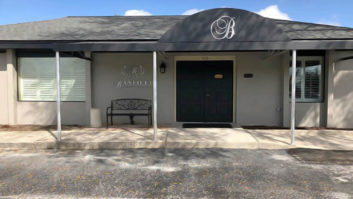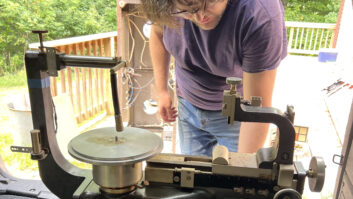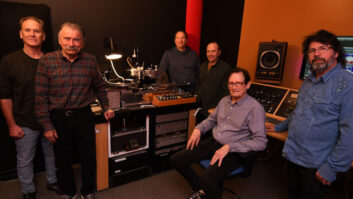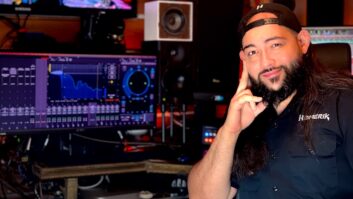By Clive Young.

Everyone loves the hardware that built Rock ‘n’ Roll. Guitars used by famous musicians wind up in museums; consoles that recorded classic tracks change hands between studios for jaw-dropping sums; and people gladly pay the Hard Rock Café for a cheeseburger, Coke and fries, just so they can sit next to a mic once used by the bald guy in Midnight Oil.
We’re all prone to pine for the good old days now and then, but when it comes to music hardware, you probably haven’t heard much rhapsodizing about legendary vinyl mastering lathes. Until now.
It never occurred to me that such a thing could be considered ‘legendary’ until the other day, when by chance, I came across two lengthy discussions about the original Stax Records lathe, which now lives at Ardent Studios in Memphis.
During lunch, I was paging my way through one of the latest books in the 33 1/3 series, Radio City, by Bruce Eaton. Named after Big Star’s renowned second album, the tiny tome recounts how the power-pop LP was recorded at Ardent, correcting a fair number of stories about the band while providing a truck-load of technical info, from mic models to how Ardent came to be. And then there’s the section about how the album was mastered December 3, 1973 on the Stax lathe:
Larry Nix: “This mastering date, they said that John Fry [owner of Ardent] was coming over to do this album. He came in, we put the tapes on. John knows all the electronic whatnots—he’d tear it apart and put it back together—he knew probably how it all worked, but I don’t think he’d ever been around the lathe or mastering. After checking it out for a while, we set the tape up and started playing it and immediately, it was totally different from anything I was doing. You’ve got to remember Stax, r&b—a whole different sound. He just turned it on and I was like, ‘Ahhh, I don’t know if I can make it work.’
“He did something—he turned up the helium that cools the coils on the cutting head to keep it cooler, because there was a lot of high-end energy that he was putting on there. There are also high frequency limiters—a fail-safe limiter that keeps the circuit breaker from breaking. If you try to put too much on there, they will actually pop a circuit breaker. I hardly ever saw these things move, much less to the extent of what they were doing. I’m almost a bystander and I was there to put the vinyl on the lathe, turn it on and drop the cutter head and make the changes between cuts, and while it was going down to the vinyl, John would actually ride those high frequency limiters to get as much high end on there as he could without it popping the circuit breakers. Being the one who mixed it, he knew where the passages were and he literally sat on a stool and did that.
“It influenced me—it taught me that the lathe would do things I didn’t know it would do. But again, you have to remember, we’d done ‘Shaft,’ ‘I’ll Take You There,’ by the Staple Singers, The Dramatics’ ‘What You See Is What You Get.’ I’d already done all these things… ‘If Loving You Is Wrong’ [Luther Ingram]…but there are no cymbals or guitars chiming away. You have to remember, this is early 1970s. The sound then is actually more of a muffled sound. At the time, they were putting towels or a wallet on the snare drum so you don’t hear the pop ring of the snare. So it changed my whole outlook. As far as the sound, I couldn’t believe it. Killer. The energy the record had, the clarity, the presence—it was like they were playing in the room.”
Not an hour after I read that passage, I got a press release here at Pro Sound News about Super 400, a power trio that recorded its latest album at Ardent, and how the band had poked and cajoled the studio into awakening the slumbering Stax lathe one last time in order to put Sweet Fist out on double vinyl:

The record was cut on the original Stax Records lathe at Ardent Studios in Memphis. The machine had cut vinyl masters for legends ranging from Al Green and Isaac Hayes to Led Zeppelin and Stevie Ray Vaughn. Though the lathe hadn’t functioned in over 20 years, the kind people at Ardent became determined to refurbish it for Super 400’s Sweet Fist before retiring it into the Stax Museum forever. Once word got out that the famous lathe was back in action, calls poured into Ardent, booking the machine for months in advance, re-establishing a physical piece of American musical history back into the fold of modern recording.
Singer/bassist Lori Friday said, “During our time at Ardent, we listened eagerly to John Fry and Larry Nix tell us the magical tales of the 1960s and 70s recording sessions and how tight the bands became with producers and engineers, and how the whole Memphis scene was one big family, all sharing an obsessive love and joy of music.
“Larry still has the original card catalog from every album cut there – it’s a magical library of memories for those guys, one that I was honored to get a close look at. Every EQ setting for every album is meticulously recorded–names like Stevie Ray Vaughan, Isaac Hayes, Big Star, Al Green; what a sight it was to get an inside look at Memphis recording history.
“The lathe is the machine that ‘cuts’ the sound to vinyl–this legendary piece of art lay inoperable in the Mastering room for years. It was a star feature in the many Ardent studio tours, drawing many oohs and ahhs from the passers-by, but Larry hadn’t cut vinyl on it in quite some time. On many occasions during our sessions there, we hinted to John and Larry, not so subtly, that we’d be tickled pink to have the Sweet Fist record cut on the old Stax lathe.
“Larry told us it wasn’t possible, that he wasn’t sure if the lathe was fixable, maybe they didn’t make the parts anymore. We continued bugging him about it, enough so that he looked into the possibility of repair. He still was unconvinced. On the last day of the Super 400 sessions, we sadly packed our gear into our trailer, and prepared to leave this magical place. I knew I had to give it one last try. I went into Larry’s office and told him how much our experience at Ardent touched us, that the stories he and John told us about the old days made us want so badly to have our own family-style memory, especially since the entire record was done at Ardent this far. Recording, mixing and mastering. He must have been feeling it too, because the next thing we knew, we were flying back down to Ardent to witness the cutting of the Sweet Fist record to vinyl, by Larry’s own hands.
“To say we are proud of this achievement is no way to describe it. It just feels so right. It was a great honor for us to make this record with the legends that became our friends. You can’t beat that.”
Ardent Studios
www.ardentstudios.com
Super 400
www.myspace.com/super400
Big Star’s Radio City [Book]
bit.ly/2FWiOM







